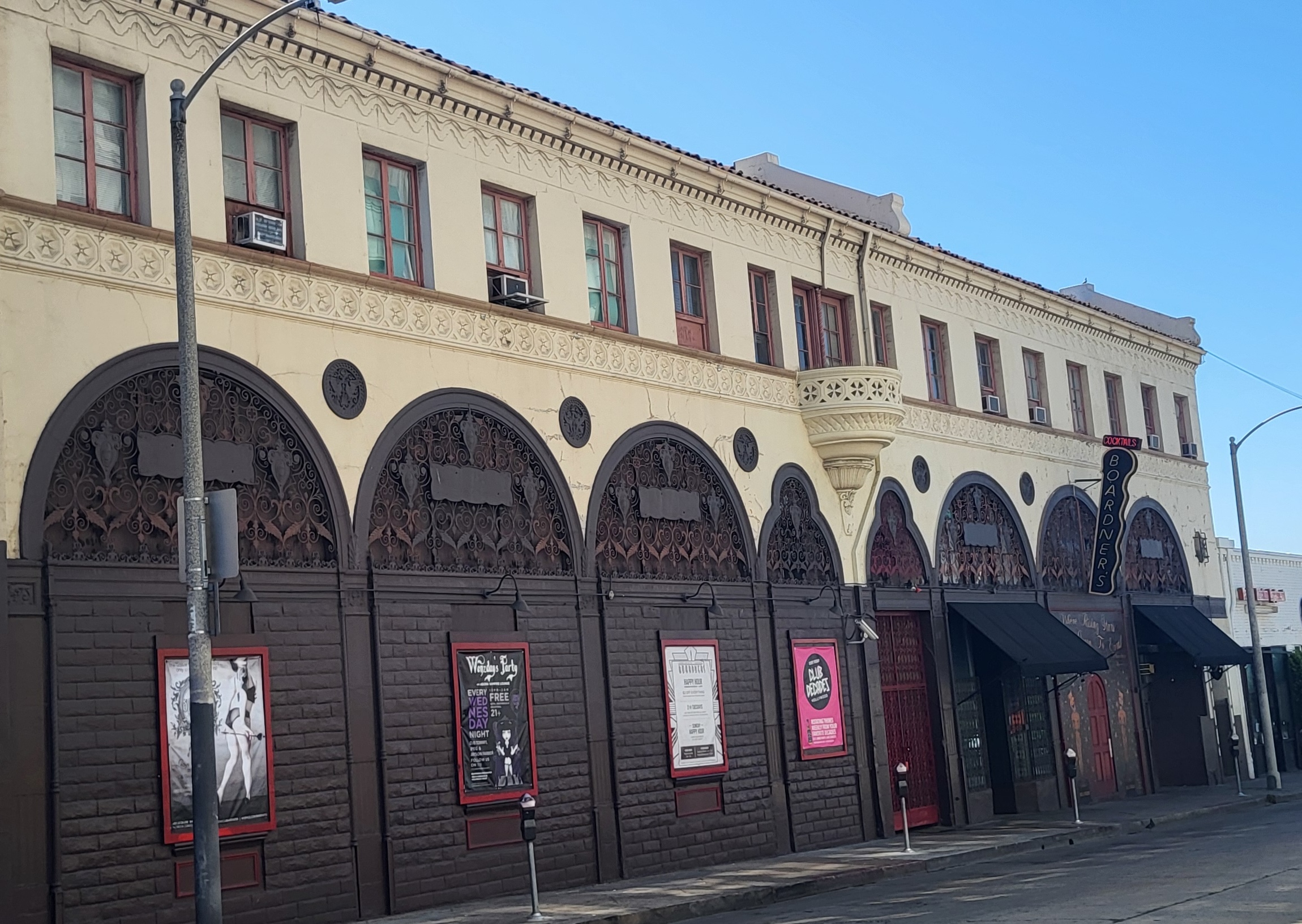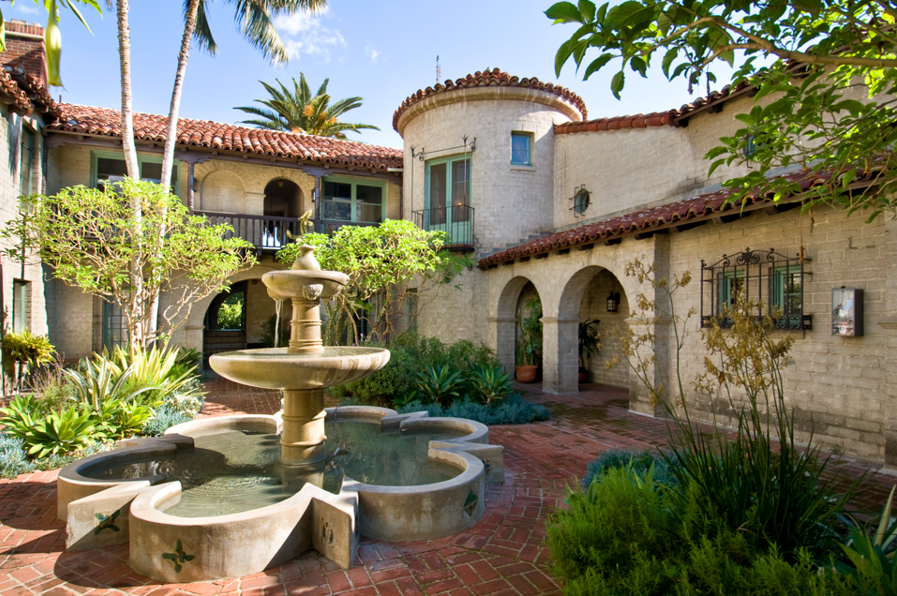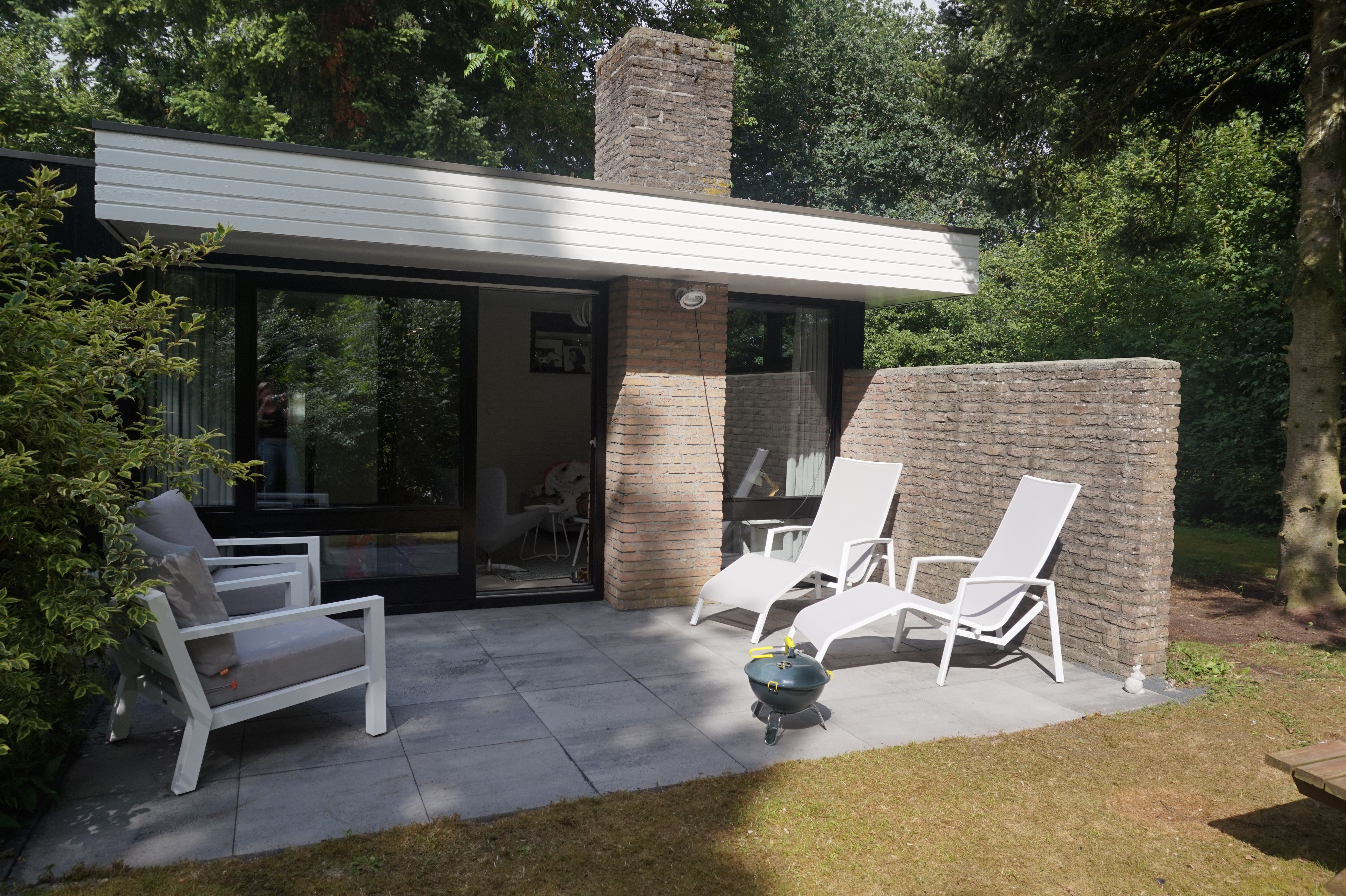|
Cherokee Building
Cherokee Building is a historic two-story commercial structure located at 6630 W. Hollywood Boulevard and 1652 N. Cherokee Avenue in Hollywood, California. History Cherokee Building was built by Norman W. Alpaugh in 1929 and features a Spanish Colonial Revival design. The building housed Hollywood's first drive-in businesses, and it catered to the automobile by having a large motor entrance at the rear where motorists could park and enter, rather than entering from the street. One of Cherokee Building's original tenants was a hair salon that acted as a front for a Prohibition-era illegal card club and gambling speakeasy. In the 1930s, Gene Austin opened a nightclub in the building, and that business was followed by several Bar (establishment), bars, including a gay bar. In 1944, the bar changed to Boardner's, whose name has remained ever since. In 1938, Larry Edmunds Bookshop moved into one of the building's storefronts. In the 1960s and 70s, several clothing stores popular w ... [...More Info...] [...Related Items...] OR: [Wikipedia] [Google] [Baidu] |
Hollywood, California
Hollywood, sometimes informally called Tinseltown, is a List of districts and neighborhoods in Los Angeles, neighborhood and district in the Central Los Angeles, central region of Los Angeles County, California, within the city of Los Angeles. Its name has become synonymous with the Cinema of the United States, U.S. film industry and the people associated with it. Many notable film studios such as Sony Pictures, Walt Disney Studios (division), Walt Disney Studios, Paramount Pictures, Warner Bros., and Universal Pictures are located in or near Hollywood. Hollywood was incorporated as a municipality in 1903. The North Hollywood, Los Angeles, northern and East Hollywood, Los Angeles, eastern parts of the neighborhood were Merger (politics), consolidated with the City of Los Angeles in 1910. Soon thereafter, the prominent film industry migrated to the area. History Initial development H. J. Whitley, a real estate developer, arranged to buy the E.C. Hurd ranch. Whitley shared ... [...More Info...] [...Related Items...] OR: [Wikipedia] [Google] [Baidu] |
Boardner's
Boardner's, also known as Boardner's by La Belle, is a historic restaurant and bar located at 1652 N Cherokee Ave, just south of Hollywood Boulevard, in Hollywood, California. It is known for its film noir atmosphere, popularity within the entertainment industry and with other notable figures, and Bar Sinister, the eldritch dance party it has hosted every Saturday since the 1990s. History Steve Boardner took ownership of his first bar, Crossroads in the Crossroads, in 1942, when a Crossroads of the World bar owner swapped his ABC license for Boardner's 1941 Pontiac. Boardner moved his bar into the nearby Cherokee Building in January 1944, at which point he renamed it Boardner's. The new location was previously home to a speakeasy and hair salon, a Gene Austin owned nightclub, and several bars, including a gay bar. In 1980, pornography businessmen Dave Hadley and Kurt Richter bought Boardner's, intending it to be a meeting place for people in the adult entertainment industr ... [...More Info...] [...Related Items...] OR: [Wikipedia] [Google] [Baidu] |
Fountain
A fountain, from the Latin "fons" ( genitive "fontis"), meaning source or spring, is a decorative reservoir used for discharging water. It is also a structure that jets water into the air for a decorative or dramatic effect. Fountains were originally purely functional, connected to springs or aqueducts and used to provide drinking water and water for bathing and washing to the residents of cities, towns and villages. Until the late 19th century most fountains operated by gravity, and needed a source of water higher than the fountain, such as a reservoir or aqueduct, to make the water flow or jet into the air. In addition to providing drinking water, fountains were used for decoration and to celebrate their builders. Roman fountains were decorated with bronze or stone masks of animals or heroes. In the Middle Ages, Moorish and Muslim garden designers used fountains to create miniature versions of the gardens of paradise. King Louis XIV of France used fountains in the Gard ... [...More Info...] [...Related Items...] OR: [Wikipedia] [Google] [Baidu] |
Patio
A patio (, ; ) is an outdoor space generally used for dining or recreation that adjoins a structure and is typically paved. In Australia, the term is expanded to include roofed structures such as a veranda, which provides protection from sun and rain. Pronunciation can vary in Australia as well: ''patty-oh'' is perhaps more common generally although ''payshee-oh'' may be used by older Australians. Construction Patios are most commonly paved with concrete or stone slabs (also known as paving flags). They can also be created using bricks, block paving, tiles, cobbles or gravel. Other kinds of patio materials these days include alumawood, aluminum, acrylic and glass. Other options include concrete, stamped concrete, and aggregate concrete. Restaurant patio ''Patio'' is also a general term used for outdoor seating at restaurants, especially in Canadian English. While common in Europe even before 1900, eating outdoors at restaurants in North America was exotic until the 19 ... [...More Info...] [...Related Items...] OR: [Wikipedia] [Google] [Baidu] |
Brick
A brick is a type of construction material used to build walls, pavements and other elements in masonry construction. Properly, the term ''brick'' denotes a unit primarily composed of clay. But is now also used informally to denote building units made of other materials or other chemically cured construction blocks. Bricks can be joined using Mortar (masonry), mortar, adhesives or by interlocking. Bricks are usually produced at brickworks in numerous classes, types, materials, and sizes which vary with region, and are produced in bulk quantities. Concrete masonry unit, ''Block'' is a similar term referring to a rectangular building unit composed of clay or concrete, but is usually larger than a brick. Lightweight bricks (also called lightweight blocks) are made from expanded clay aggregate. Fired bricks are one of the longest-lasting and strongest building materials, sometimes referred to as artificial stone, and have been used since . Air-dried bricks, also known as mudbricks ... [...More Info...] [...Related Items...] OR: [Wikipedia] [Google] [Baidu] |
Moorish Arch
The horseshoe arch (; ), also called the Moorish arch and the keyhole arch, is a type of arch in which the circular curve is continued below the horizontal line of its diameter, so that the opening at the bottom of the arch is narrower than the arch's full span. Evidence for the earliest uses of this form are found in Late Antique and Sasanian architecture, and it was then used in Spain by the Visigoths. But in the 19th century, perhaps when these earlier uses had not been realized, it became emblematic of Islamic architecture, especially Moorish architecture and Mozarabic art in Iberia. It also made later appearances in Moorish Revival and Art Nouveau styles. Horseshoe arches can take rounded, pointed or lobed form. History Origins and early uses The origins of the horseshoe arch are complicated. It appeared in pre-Islamic Sasanian architecture such as the Taq-i Kasra in present-day Iraq and the Palace of Ardashir in southwestern Iran (3rd century CE). It also appeared in ... [...More Info...] [...Related Items...] OR: [Wikipedia] [Google] [Baidu] |
Tile
Tiles are usually thin, square or rectangular coverings manufactured from hard-wearing material such as ceramic, Rock (geology), stone, metal, baked clay, or even glass. They are generally fixed in place in an array to cover roofs, floors, walls, edges, or other objects such as tabletops. Alternatively, tile can sometimes refer to similar units made from lightweight materials such as perlite, wood, and mineral wool, typically used for wall and ceiling applications. In another sense, a tile is a construction tile or similar object, such as rectangular counters used in playing games (see tile-based game). The word is derived from the French Language, French word ''tuile'', which is, in turn, from the Latin Language, Latin word ''tegula'', meaning a roof tile composed of fired clay. Tiles are often used to form wall and floor coverings, and can range from simple square tiles to complex or mosaics. Tiles are most often made of pottery, ceramic, typically Ceramic glaze, glazed for ... [...More Info...] [...Related Items...] OR: [Wikipedia] [Google] [Baidu] |
Stringcourse
A belt course, also called a string course or sill course, is a continuous row or layer of stones or brick set in a wall. Set in line with window sills, it helps to make the horizontal line of the sills visually more prominent. Set between the floors of a house, it helps to make the separate floors distinguishable from the exterior of the building. The belt course often projects from the side of the building. Georgian architecture is notable for the use of belt courses. Although the belt course has its origins as a structural component of a building, by the 18th century it was almost purely a decorative element and had no functional purpose. In brick or stone buildings taller than three stories, however, a shelf angle is usually used to transfer the load of the wall to a hidden, interior steel wall. Flashing is used to cover the space exposed by the shelf angle to help limit the intrusion of water. Where flashing is considered aesthetically unpleasing, a belt course is often us ... [...More Info...] [...Related Items...] OR: [Wikipedia] [Google] [Baidu] |
Concrete
Concrete is a composite material composed of aggregate bound together with a fluid cement that cures to a solid over time. It is the second-most-used substance (after water), the most–widely used building material, and the most-manufactured material in the world. When aggregate is mixed with dry Portland cement and water, the mixture forms a fluid slurry that can be poured and molded into shape. The cement reacts with the water through a process called hydration, which hardens it after several hours to form a solid matrix that binds the materials together into a durable stone-like material with various uses. This time allows concrete to not only be cast in forms, but also to have a variety of tooled processes performed. The hydration process is exothermic, which means that ambient temperature plays a significant role in how long it takes concrete to set. Often, additives (such as pozzolans or superplasticizers) are included in the mixture to improve the physical prop ... [...More Info...] [...Related Items...] OR: [Wikipedia] [Google] [Baidu] |
Cherokee Bldg Side
The Cherokee (; , or ) people are one of the Indigenous peoples of the Southeastern Woodlands of the United States. Prior to the 18th century, they were concentrated in their homelands, in towns along river valleys of what is now southwestern North Carolina, southeastern Tennessee, southwestern Virginia, edges of western South Carolina, northern Georgia and northeastern Alabama with hunting grounds in Kentucky, together consisting of around 40,000 square miles. The Cherokee language is part of the Iroquoian language group. In the 19th century, James Mooney, an early American ethnographer, recorded one oral tradition that told of the tribe having migrated south in ancient times from the Great Lakes region, where other Iroquoian peoples have been based. However, anthropologist Thomas R. Whyte, writing in 2007, dated the split among the peoples as occurring earlier. He believes that the origin of the proto-Iroquoian language was likely the Appalachian region, and the split between ... [...More Info...] [...Related Items...] OR: [Wikipedia] [Google] [Baidu] |
PropertyShark
PropertyShark is an online real estate database and property research tool that provides building details, ownership information, comparable sales, and foreclosure data to real estate professionals in New York and other major U.S. markets. Launched in January 2003 by Matthew Haines, the real estate database and research website was acquired by Yardi Systems and integrated into its suite of software in 2010. History PropertyShark was founded by real estate investor and software developer Matthew Haines following his work on renovating a five-family brownstone in Harlem. The initial website launched on New Year's Day in 2003 and was first named MatthewHaines.com and later changed to NYCpropertyresearch.com. Haines reportedly created PropertyShark to make real estate data more accessible and help potential homeowners become more comfortable in investing in the neighborhood. In 2004, Haines was joined by his college friend, Ryan Slack, who became co-owner and CEO A chief executiv ... [...More Info...] [...Related Items...] OR: [Wikipedia] [Google] [Baidu] |
Contributing Property
In the law regulating historic districts in the United States, a contributing property or contributing resource is any building, object, or structure which adds to the historical integrity or architectural qualities that make the historic district significant. Government agencies, at the state, national, and local level in the United States, have differing definitions of what constitutes a contributing property but there are common characteristics. Local laws often regulate the changes that can be made to contributing structures within designated historic districts. The first local ordinances dealing with the alteration of buildings within historic districts was enacted in Charleston, South Carolina in 1931. Properties within a historic district fall into one of two types of property: contributing and non-contributing. A contributing property, such as a 19th-century mansion, helps make a historic district historic, while a non-contributing property, such as a modern medical cli ... [...More Info...] [...Related Items...] OR: [Wikipedia] [Google] [Baidu] |







